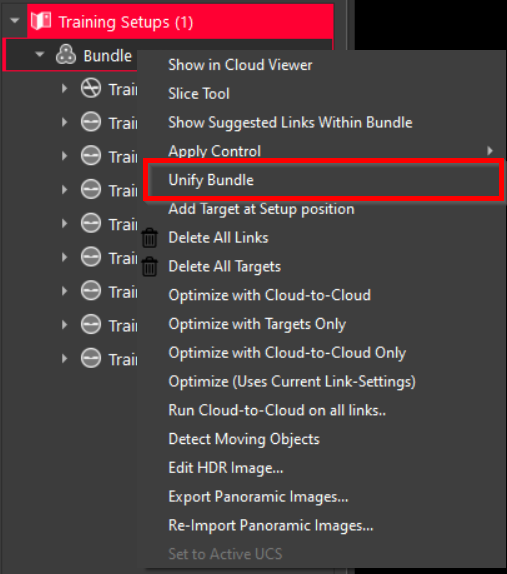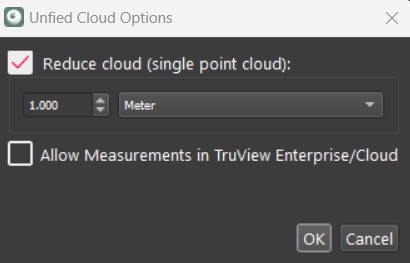Unified Point Cloud Creation
Cyclone REGISTER 360 PLUS provides a feature that allows the creation of a single unstructured Setup from an existing Bundle. This is particularly useful for large or complex projects, such as multi-day scans or projects with multiple teams, as it helps keep everything organized and manageable.
Creating a Unified Point Cloud from the Selected Bundle
The unified point cloud can be created in the Review and Optimize stage as follows:
Right-click the selected Bundle and choose Unify Bundle from the context menu.

In the Unified Cloud Options dialog that will appear, select the desired option:
Reduce cloud (single point cloud): Allows decimating a point cloud by resampling at a desired gridded distance.
Unit settings: Activated if the Reduce cloud (single point cloud) check box is selected, enabling adjustments to point spacing and units of measurement.
Allow Measurements in TruView Enterprise/Cloud: Enables the inclusion of the depth image in the exported Setups to allow measurements in TruView Enterprise and TruView Cloud.

A new unstructured Setup will be created that includes the point cloud, where the Setups from the Bundle will be converted to WayPoints, and the data will be in a single unified cloud (without the Links).
As a best practice, move it to a new SiteMap where you can link the unstructured Setup with other data.
Feature Benefits
Complex projects: Ideal for projects with multiple stages, such as multi-day scans or different sections of a site, allowing better management and tracking of progress.
Large projects with too many Setups: Helps handle very large projects by splitting them into sub-projects, reducing processing times, memory usage, and network instability.
Error management: Keeps different stages separate to prevent errors from propagating through the entire project.
Efficiency: Optimizes data storage and speeds up the Finalize and Report steps, making the creation of the finalized registration cloud faster.
Use Case 1
Consider a multi-day scanning project with extensive scanning done each day. The Setups for Day 1 can be bundled together after quality checks to ensure the registration quality. Now that data for Day 2 will continue the work from Day 1. Once collected, the data can be imported and connected to the Bundle formed on Day 1.
While there are benefits to keeping the structured Setups and Bundle, there might be limitations as well. For example, it can be difficult to track project progress based on one Bundle or to separate a specific day to identify an issue or locate a markup. This can be achieved using SiteMaps, but this approach may not be suitable for certain workflows. Additionally, if there is an issue in one of the Links created on Day 2, the error from that Link will propagate to the entire network, including the Day 1 Links that were QA’ed and verified.
In such cases, the project manager may want to keep Day 1 separate and once verified, create a unified cloud for the entire Bundle. Then, the same procedure can be followed for Day 2, and so on, to form a new Bundle with the unified cloud for multiple days.
Use Case 2
Consider a Project is very large and contains many Setups (e.g., 2,000), which can lead to long processing times, high memory usage, network instability, and potential data loss or corruption. One simple approach is to split the project into sub-projects, use the Unify Bundle command for each subproject, and then form a new large Bundle for the project that connects the subprojects. This way, the stability and accuracy of the project are ensured in subprojects, and then a final Bundle can be formed while addressing some of the major limitations of supporting a large number of Setups.
